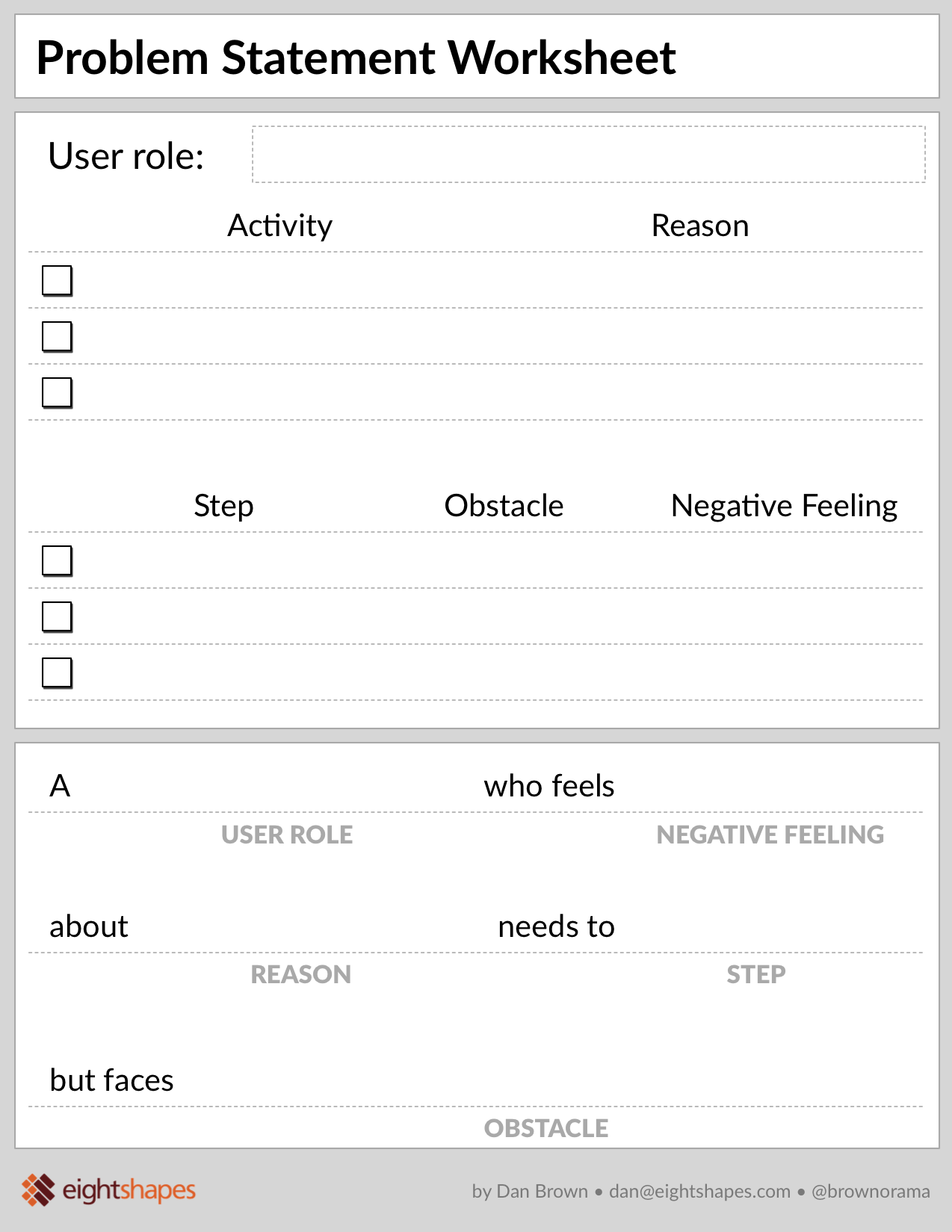What is a problem statement, and how do you write one? Look no further. We’ll show you everything you need to know in this guide.
The user experience design process is all about solving problems, but unless you define the problem, your design may miss the mark. This is why creating a problem statement for each project you tackle is so important. A problem statement, which can also be referred to as a POV statement or user need statement, succinctly sums up the problem or pain point users need you to solve with your design.
By creating a problem statement, you ensure your team, including stakeholders and clients, are all on the same page about who you’re designing for, the problem you plan to help them with, and why it’s important. Ultimately, articulating these things through a well-considered, user-centric problem statement means your whole team will be working toward the same design goals.
In this guide, we’ll tell you everything you need to know about problem statements. Here’s what we’ll cover:
- What is a problem statement? A definition
- When should a problem statement be created?
- How to write a problem statement
- Problem statement examples
Ready? Let’s go.
1. What is a problem statement?
A problem statement sums up the user pain-point or problem you’ll seek to solve with your design.
A problem statement is an actionable summary of your user, their goals, and what you need to solve to meet those goals. It sets the course for your project’s user experience; however, it shouldn’t include anything about the design elements or user functionality you might employ to solve the problem. Instead, it should provide insight into why you’re designing the user experience to begin with.
In other words, a user doesn’t need to be able to use two-factor authentication to get into a banking app, they need to be able to access their banking information securely. The problem statement should lay out the user’s need (secure access) but leave out any possible solutions (two-factor authentication), which shouldn’t be considered until further along in the design process.
2. When should a problem statement be created?
Problem statements are created during the define stage, the second step in the Design Thinking process. This stage builds on the previous step, the empathize phase, in which you and your team perform user research to learn about the people who will utilize the product you’re designing, including their needs, desires, and challenges. Once you understand your users, you can’t move right into generating design solutions because you don’t yet have a specific objective for the user experience you’re creating. That’s what makes the define stage and problem statements so essential.
The problem statement you create in the define stage will be your team’s guiding light in the ideate phase, and all the remaining stages, in the Design Thinking process.
Ultimately, you need to write a problem statement whenever you’re setting out to solve a user pain-point through design. So how do you go about writing an effective problem statement? Let’s find out.

3. How to write a problem statement
There are several techniques UX designers employ to arrive at a succinct but well-thought-out problem statement. These include:
The 4 Ws
In the 4 Ws technique, you use the information you gathered in the empathize phase to answer the key questions: who, what, where, and why. Whether in collaboration with other members of the team or on your own, you will ask and answer questions that begin with the 4 Ws. This will enable you to describe who your users are, what they want, where they’ll use your product, and why their problem is important. For example, you could ask:
- Who: Who is impacted by this issue? Make sure to get specific by including information from what you know about users’ demographics, psychographics, personas, and other findings from user research.
- What: What is the problem? What are the obstacles users are facing? What are they trying to do? What will make the process less difficult?
- Where: Where will they be using the product? Is there a specific context in which the problem comes up? Is the issue purely digital or is there a physical component?
- Why: Why is this important? Why will users benefit from solving this problem?
By asking questions based on the four Ws and brainstorming answers, you’ll be able to put into words the most important observations that came out of your user research, which you can then synthesize to arrive at a use-centric problem statement.
The 5 Whys
Much like the 4 Ws technique, the 5 Whys revolves around asking a series of simple questions, but in this case every one of those questions is “Why.” This technique helps you drill down on a problem to uncover its root cause by repeatedly asking a why question in response to your previous answer.
For example, perhaps during user research you discovered that a user named Jordan doesn’t have enough clothes to wear to work. Here’s how you can ask why to get to the root of their problem:
- Why doesn’t Jordan have enough clothes to wear to work? Because they don’t own enough business casual clothing.
- Why doesn’t Jordan own enough business casual clothing? They haven’t shopped for clothes in over a year
- Why haven’t they shopped for clothes in over a year? Jordan hates to shop
- Why does Jordan hate to shop? They get overwhelmed by the choices available
- Why does Jordan get overwhelmed by the choices available? Jordan doesn’t know what clothes will look best on them
The fifth question indicates that the cause of Jordan’s problem is that they don’t know what clothes will look best on them. As a result, your problem statement should focus on Jordan’s need for assistance to find the best clothes options when shopping.
While this technique is referred to as the 5 Whys, the number five is only a rule of thumb. In order to determine the root cause of a user’s problem, you may need to ask why more or less than five times. Either way, when you use this technique, you should stop asking why once your answers are no longer valuable in defining the problem.
Moreover, when using this technique, make sure each answer to a “why” question is grounded in a real world issue so you can reach a concrete conclusion about the reason for the users’ challenge. In addition, you may find that the answer to each “why” question has more than one legitimate answer. If this is the case, you should follow each branch of questioning because it could reveal your user has more than one problem they need help with.
Fill-in-the-blank
In order to be useful, a problem statement must be brief, point to a user need, and help set a goal for the design of the project’s user experience. In order to ensure a problem statement captures those components, several UX professionals have created simple fill-in-the-blank formulas and templates that can be used when writing problem statements.
For example, the Nielsen Norman Group’s Sarah Gibbons provides a simple structure for a problem statement that includes three components:
- A user
- A need
- A goal
These are then combined following the pattern: “[A user] needs [need] in order to accomplish [goal].” For example, if the user is a dog owner, your problem statement might be: “A dog owner [user] needs to spend more time playing with their dog [need] in order to keep him engaged and happy [goal].
Similarly, designer Dan Brown provides a worksheet for building a problem statement that includes several steps that end in a complete problem statement. The first step involves identifying a specific user. This user should be based on a persona or profile from the empathize phase of the Design Thinking process, and should include details about the job (trial lawyer, diner cook, college student) or role (parent, dog owner, sibling) that makes them relevant to the project.

Next, taking the perspective of the user, specify three activities they engage in during the week and the reason each of those things is important. For example, a dog owner:
- Takes their dog for a walk because the dog needs to relieve himself.
- Plays with their dog so their dog can stay engaged and happy.
- Provides fresh water each day so their dog stays hydrated.
After this, take one of the three activities and break it down into the steps the user must take to complete the task, an obstacle they might encounter at each step, and how that makes the user feel. For example, if we expand on the activity of the dog owner playing with their dog, we might write:
- Find time to play with dog — busy with work — worried
- Give dog a choice of toys — dog has trouble choosing — bored
- Play fetch with dog — dog only brings the toy back half the time — frustrated
Finally, you can choose one of these three steps to develop into a problem statement based on the following formula: A [user] who feels [negative feeling] about [reason] needs to [step] but faces [obstacle]. So using the example of a dog owner, you can write a problem statement like: A dog owner [user] who feels worried [negative feeling] about their dog staying engaged and happy [reason] needs to find time to play with him [step], but is too busy with work [obstacle]. This template is a good starting point for helping you think through your users’ problems and, ultimately, arrive at meaningful problem statements.

4. Problem statement examples
A problem statement is a way to explain the problems users need your UX design to solve and why. However, if it’s too broad, it will leave too many possible solutions open, making it challenging to arrive at the best one. As a result, keep in mind when writing a problem statement that it should be broad enough to allow for creative thinking and innovative solutions, but narrow enough that it can provide a direction for that solution.
That said, there is no one right way to create a problem statement. No matter how you reach your final problem statement, it should be user-focused, which means it should begin with identifying a user and their need and include an idea of why they require that need to be met.
Here are some good examples of problem statements.
Problem statement from the user’s point of view: This kind of problem statement names a specific user and explains what they need from their perspective.
- I am a parent who wants to make sure my children don’t fall for scams on the internet, but I don’t know the best way to teach these skills because I can’t find high quality resources that explain the best way to do so, leaving me feeling uncertain.
- I am a young professional who wants to exercise regularly but I spend long hours at the office so I usually can’t make it to a gym before it closes, which frustrates me.
- I am a grandparent who wants to be able to easily see and talk to my grandchildren on a weekly basis, but I can’t because they don’t live nearby, which makes me feel lonely and disconnected.
- I am a single young adult who just moved to a new city where I don’t know anyone and don’t know where to go to meet people and make friends. As a result, I feel isolated.
Problem statements based on user research: This kind of problem statement pinpoints a group of users identified during user research and states what they need and why they need it.
- Parents need a way to quickly and easily access high-quality information about teaching their kids how to avoid internet scams because currently it is hard to find resources about this topic, which leads to uncertainty.
- Young professionals need a way to exercise regularly even though they work long hours, making it frustratingly difficult to get to the gym before it closes.
- Grandparents need a way to easily see and speak with their grandchildren on a weekly basis even though they don’t live nearby so they won’t feel lonely and disconnected.
- Single young adults who move to a new city where they don’t know anyone need to know where to go to meet people and make friends so they don’t feel isolated.
Problem statements based on the 4 Ws: This kind of problem statement uses the 4 Ws technique to create a statement that outlines who has the problem, what that problem is, and where they experience it, and then explains why your solution should deliver a specific user experience to solve the user’s problem. In order to encourage brainstorming in the next phase of the Design Thinking process, you can state the last part of this kind of problem statement in the form of a question.
- A parent’s problem is that he wants to teach his kids how to avoid scams when they’re using the internet. How can we ensure he can get all the best resources on the topic he needs so he can avoid uncertainty?
- A young professional’s problem is that she needs a way to exercise regularly even though the long hours she works make it difficult for her to get to the gym. How can we give her an alternative option for exercise that will require no gym equipment and allow her to work out in her own time and space so she won’t be frustrated when she can’t make it to the gym?
- A grandparent’s problem is that they want to see and speak with their grandchildren on a weekly basis, but can’t do so in person because their grandchildren don’t live nearby. How can we give them a way to easily reach their grandchildren so this grandparent doesn’t feel lonely and disconnected from them?
- A single young adult’s problem is that she doesn’t know anyone in the new city she just moved to. How can we help her figure out where to go to meet people and make friends so she doesn’t feel isolated?
Problem statements using the fill-in-the-blank approach: For this kind of problem statement you can simply fill in the blanks in one of the problem statement templates provided in the previous section, such as this one: [A user] needs [need] in order to accomplish [goal].
- A parent of two needs to find high-quality resources in order to successfully teach his kids how to avoid internet scams.
- A young professional who works long hours needs to find a way to work out outside a gym in order to fit in regular exercise.
- A grandparent needs to easily see and speak with their grandchildren, who live too far away for them to see in person, in order to avoid feeling lonely and disconnected from them.
- A single young adult who just moved to a new city needs to figure out where to go to meet people so she can make friends and no longer feel isolated.
You’ve likely noticed that some of these problem statement examples focus on specific design issues that may make up only part of a larger project. If you are tackling a large project, you’ll likely want to create an overarching “umbrella” problem statement that articulates the project’s overall objective and additional problem statements for each component of the project.
In addition, if a specific component of your project is especially complicated, you may want to create a “parent” problem statement that describes a general goal along with several “child” problem statements that set sub-goals. However, this doesn’t mean problem statements should be created haphazardly. You should only create as many problem statements as are necessary to define the scope of your project.
Now that you know how to write a UX problem statement, you might want to learn more. If so, you’ll find the following articles useful:
